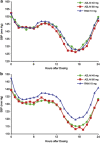Antihypertensive efficacy of the angiotensin receptor blocker azilsartan medoxomil compared with the angiotensin-converting enzyme inhibitor ramipril
- PMID: 23514842
- PMCID: PMC3715765
- DOI: 10.1038/jhh.2013.6
Antihypertensive efficacy of the angiotensin receptor blocker azilsartan medoxomil compared with the angiotensin-converting enzyme inhibitor ramipril
Abstract
Drug therapy often fails to control hypertension. Azilsartan medoxomil (AZL-M) is a newly developed angiotensin II receptor blocker with high efficacy and good tolerability. This double-blind, controlled, randomised trial compared its antihypertensive efficacy and safety vs the angiotensin-converting enzyme inhibitor ramipril (RAM) in patients with clinic systolic blood pressure (SBP) 150-180 mm Hg. Patients were randomised (n=884) to 20 mg AZL-M or 2.5 mg RAM once daily for 2 weeks, then force-titrated to 40 or 80 mg AZL-M or 10 mg RAM for 22 weeks. The primary endpoint was change in trough, seated, clinic SBP. Mean patient age was 57±11 years, 52.4% were male, 99.5% were Caucasian. Mean baseline BP was 161.1±7.9/94.9±9.0 mm Hg. Clinic SBP decreased by 20.6±0.95 and 21.2±0.95 mm Hg with AZL-M 40 and 80 mg vs12.2±0.95 mm Hg with RAM (P<0.001 for both AZL-M doses). Adverse events leading to discontinuation were less frequent with AZL-M 40 and 80 mg (2.4% and 3.1%, respectively) than with RAM (4.8%). These data demonstrated that treatment of stage 1-2 hypertension with AZL-M was more effective than RAM and better tolerated.
Figures



References
-
- Wolff-Maier K, Cooper RS, Banegas JR, Giampaoli S, Hense HW, Joffres M, et al. Hypertension prevalence and blood pressure levels in 6 European countries, Canada and the United States. JAMA. 2003;289 (18:2363–2369. - PubMed
-
- Whitworth JA, World Health Organization, International Society of Hypertension Writing Group World Health Organization (WHO)/International Society of Hypertension (ISH) statement on management of hypertension. J Hypertens. 2003;21 (11:1983–1992. - PubMed
-
- Turnbull F, Neal B, Pfeffer M, Kostis J, Algert C, Woodward M, et al. Blood pressure dependent and independent effects of agents that inhibit the renin-angiotensin system. J Hypertens. 2007;25 (5:951–958. - PubMed
Publication types
MeSH terms
Substances
LinkOut - more resources
Full Text Sources
Other Literature Sources
Medical

